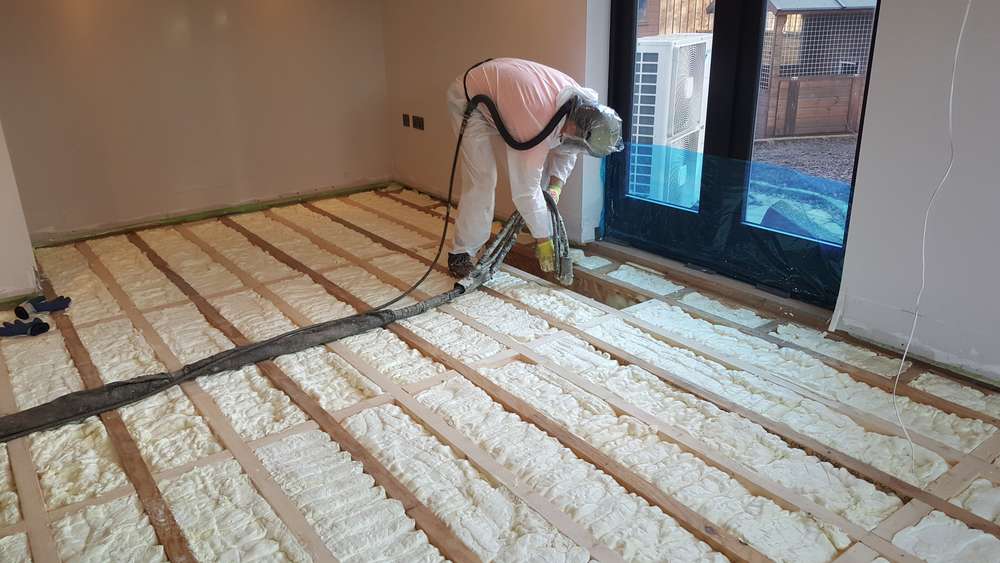Attic Spray Foam Insulation Longwood
3 Bed Semi Attic Insulation Longwood

Attic Insulation Longwood
Spray foam can be useful in many conditions. Spray foam is useful in roofs, windows, attics, underfloor heating systems, interior and exterior walls, as well as roofs.
Spray foam insulation will keep your home warm during winter and cool in summer. The “Cell” structure of the composition allows for moisture to escape, which helps to allow the house to breathe.
Benefits of Spray Foam Insulation for your home
Other uses include: commercial and industrial buildings; agricultural farms houses; sheds; shipping containers; vessels; and the refrigeration industry.
It also acts as an airtight shield around the house to keep out cold wind and rain. It allows the heat from your home to escape, which is what most other insulating products today fail to do.


Cost Price Of Spray Foam Insulation
Spray foam insulation can be regarded as the most efficient insulation material. It has a higher insulating value than other materials like rock wool or fiberglass.
Spray foam insulation is also a good sound barrier. Spray foam insulation significantly reduces noise from outside. This is particularly beneficial if the home or business is located near an airport or densely populated city.
Insulate Your Longwood Property Properly
It’s commonly used to block sound from traveling between rooms or floors. It is particularly useful in bathrooms, where the noises of flushing toilets and showers can be annoying.
It is easy to use and does not cause any disruptions to your daily activities.
An Irish traditional home can be insulation in one day.
It reduces the noise of in-wall and under-floor pipes by encasing them and isolating them.

Plan to store things in your loft or attic, so you’ll need to put boards on top of the joists. You won’t get thick insulation if the insulation isn’t thick enough if the insulation is only applied between the joists.
This material reduces the sound transference significantly when it is used within walls, attics or roofs, as well as floors, in comparison with fibreglass, rock wool, and polystyrene board. Its dense composition, and its application process results in an envelope that is completely airtight. It keeps out sounds from the environment like traffic, pedestrianised streets and homes near airports.
Spray foam insulation also stops sounds from within a structure being transmitted to floors below, above, or into adjacent rooms. Spray foam insulation will dramatically reduce the sound levels of many noises within a structure, including talking, hair dryers (phones), office computers and printers as well as running showers, laundry machines, clothes dryers.
Spray foam insulation is flexible and filled with millions upon millions of microscopic air bubbles. This not only absorbs the vibrations and stops sound from passing through the floor, but also prevents sound from being transferred. Spray foam insulation reduces sound transmission by sealing any cracks or crevices that airborne noises can travel through.
Spray foam insulation is also effective in dampening, if no longer completely eliminating, any sounds that might be emanating from a floor like water running through pipes. It surrounds pipes securely, preventing them rattling. It eliminates the sound that is made when hot water flows through pipes from heating system. This causes wooded joints to expand, creak, and groan.
It also stops heat from escaping to the upper levels, which makes the lower floors cooler and requires more heat to keep them warm.
It is possible to insulate lofts if they are accessible and have no damp or condensation issues.
In an uninsulated house, 25% of heat escapes through the roof. Insulating your flat roof, attic, or loft can help reduce heat loss and decrease your heating costs.
Rolls of mineral wool insulation can be used if access is good and the loft joists have regular dimensions. The insulation begins by placing the first layer between the joists. These are the horizontal beams that form the loft’s floor. A second layer is then laid at right angles to cover and seal the joists.
To ensure sufficient insulation, raise the floor height so that you can place enough mineral wool below the new floor. Timber battens can be fitted across the joists. Alternatively, you can purchase purpose-built plastic legs to fit onto the joists and support your new floor. To prevent condensation from forming on the boards’ undersides, it is important to ventilate the air gap between insulation and boards.
You should not squash the mineral wool while you place the boards on top. This will decrease its insulation value.
Insulation prevents heat from escaping living spaces. It will make loft space more comfortable and less humid. This could lead to dampening or worsening existing condensation or damp problems. You may need to increase ventilation if you install loft insulation yourself.
Another way to insulate your loft would be to place insulation between and above the rafters. These are sloping timbers which make up the roof. You can either use rigid insulation boards which are cut precisely to fit your loft, or spray foam insulation between the roof rafters.
Some companies may offer to repair your roof with foam insulation. We don’t recommend this. It is important to ensure that your roof remains dry before installing insulation.
You can use your loft to heat the space, but you will need to create a separate room on the roof.
You will need to insulate the loft walls and ceilings if you intend to use it as your living space.
The air needs to move freely through your house in order to keep it fresh, dry and healthy. An experienced installer will not block or seal any intended ventilation. Do not cover any grilles, vents, or airbricks if you do DIY insulation.
You can have blown insulation installed if your loft is difficult to access. A professional will use specialist equipment and blow the right insulation material into every space. They may use mineral wool fibres, treated cellulose foam or polyurethane.
Flat roof insulation could help you save similar heating bills as loft insulation. The amount of flat roofing on a property will determine how much savings you get.
You can probably insulate your loft yourself if it is accessible and does not have damp problems. If there are damp issues or more complex insulation needs, a professional should be hired.
Your loft hatch could become colder due to the cooler air. This can be prevented by installing an insulated hatch in your loft and putting strips of draught-exclusion material around the hatch edges.
Insulating your groundfloor is a great way for your property to stay warm as well as lowering your energy bills.
Insulating a loft can be one of the best ways to lower your heating bills, save money on energy and keep your home warm during the winter. Even if you already have insulation, it is crucial to have the best amount in order to make it effective.
Loft floor rolls – These are the classic option. They are laid along the loft’s floor. They are quicker to lay than insulated flooring boards. They come in both loose and encapsulated (blankets) rolls. These can be used to create base and top layers. You can use stilts or boards to board them. This will create a raised platform that is suitable for storage.
These are not recommended items or tips that were included in the list of tools and materials. Make sure you read the entire article to ensure you are fully equipped to insulate your loft floor safely.
While insulation may be present in most homes, it may not have the right level of effectiveness. This could be due either to storage boards being placed on top of it, or because the insulation has not been maintained for a long period. In some older properties, the loft floor may only be 25mm deep.
It’s not necessary to remove loft floor insulation. To achieve the recommended amount, you can just add one or several layers to it. This article will cover more details on the amount that is recommended.
Your loft floor’s spacings will dictate the width of your roll. This is because insulation is rolled between these joints. We recommend you select one that’s close to the spacing of your joists. This minimizes the need to trim.
The insulation must have the required thermal resistance. You can also measure the insulation’s thickness using a faster method if you’re only installing loft rolls. You can find more information in the section “How to calculate loft floor insulation thickness”
Areas We Service


Parkhill, Dublin
01 5255297

